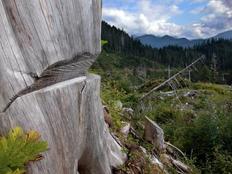 By the Juneau Empire Logging in Southeast Alaska’s Tongass National Forest is an industry that faltered many times before getting off the ground. Yet once it did, it took off with the momentum of a steam engine and with support from all over the state. “Hereafter in Alaska the 14th day of July will be celebrated as the anniversary of one of the most important events in the territory’s history,” B. Frank Heintzleman, then-governor of the territory wrote of the dedication of the Ketchikan Pulp Company. “This is not only the first plan of its kind in Alaska, but also represents the largest single industrial investment ever made here. It is an important milestone on Alaska’s road to full industrial development.” The year was 1954 and, at the time, the U.S. Forest Service openly accepted that best practices for silviculture was clear cutting. In 1972, the Forest Service even put out a brochure detailing how the practice of clearing entire stands of forest was the best way to ensure light reached the forest floor. By the 1980s, a number of small mills had opened up across Southeast, and the new Native corporations had gotten into the business. It was a time of prosperity under a plan that was about to change drastically over the next few decades as federal agencies enacted tighter regulations and passed laws meant to protect national forest lands, but which ultimately drove the region’s timber industry to near-extinction. History has shown there can be a viable timber industry in Southeast Alaska, but past practices did not take into consideration the sustainability that must exist in a region like few others in the world. It is a region we feel should be protected. The Big Thorne Timber Sale will be the largest sale in some time and outlines the harvesting of some 5,000 acres of old growth forest. Whether or not that sale comes to fruition is up to the courts to decide. There are better plans out there, ones that don’t subscribe to the historical practice of clear-cutting. Now is the time to move forward because as history has taught, change doesn’t go over smoothly when so many players — conservation groups, regulatory agencies, business folks and industry experts — believe they know what sort of change is best. We support future logging on the Tongass, but we want to see sustainable practices put into play. Timber harvests, unlike North Slope oil, don’t have to be a finite resource. An example of one such plan was brought to our attention by Dominick DellaSala, chief scientist for the GEOS Institute, and Catharine Mater, vice president of Mater Engineering, both out of Oregon. Their team focused on a plan that uses young growth trees (those growing in once-harvested areas), while protecting sensitive areas such as karst, existing no-cut buffers and old-growth forest. The numbers look promising. “We focused on logs that can easily go to market,” DellaSala said. “… Areas that already had some thinning … where the trees grow bigger, quicker.” With that narrowed focus, the team identified about 36,000 acres of timber ready for logging. Over 50 years, that acreage would be able to provide more than the minimum amount of board feet per year to float the existing mills in the region, according to the study, including Viking Lumber (which was interviewed as part of the study) on Prince of Wales Island. If logged at a controlled pace — 35 million board feet per year of log supply, for instance — a mill located in the POW region would produce approximately 70 million board feet of lumber per year and create 150 full-time equivalent direct jobs. There’s a catch: The Forest Service, under a plan of this nature, would have to change the age at which trees can be harvested. Tree growth rates decelerate around 90 years, and regulations say you can’t cut before that. The report from DellaSala and Mater assumes trees would be cut at 55 years old. “If we do that, we’ll have a ‘wall of wood,’” DellaSala said. The plan has its skeptics, but we like the environmental safeguards it supports. Furthermore, lawsuits over second-growth harvests are few and far between. If loggers don’t have to worry about lawsuits, they can harvest in peace. Simply cutting trees does not equal a viable industry, and whether regulatory agencies move toward this plan or some other, we want to see the byproduct stay in the state. In the end, we need a vibrant timber industry based on sustainability. It can be done. Care and cooperation must be at the forefront of these efforts, because the Tongass National Forest is one of the last remaining intact temperate rainforests on Earth. That must always be our highest consideration. Empire editorials are written by the Juneau Empire’s editorial board. Members include Publisher Rustan Burton, rustan.burton@juneauempire.com; Director of Audience Abby Lowell,abby.lowell@juneauempire.com; Managing Editor Charles L. Westmoreland, charles.westmoreland@juneauempire.com; and Asst. Editor James Brooks, james.k.brooks@juneauempire.com. Comments are closed.
|
Categories
All
Archives
November 2021
|
AMERICA'S SALMON FORESTis a coalition of sport, commercial, and subsistence fishermen, business owners and operators as well as private citizens working together to conserve high-quality salmon and trout spawning and rearing habitat in the Tongass, America's largest national forest.
|
CONNECT
|

 RSS Feed
RSS Feed